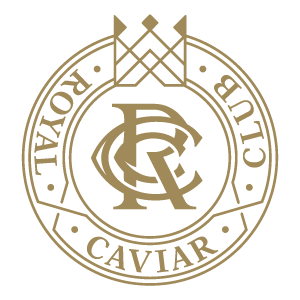Royal Caviar Club | FAQs
| WHAT IS CAVIAR? |
| The term ‘caviar’ comes from the Persian word Khaviar, which means ‘cake of power’. Caviar is the eggs of the sturgeon and no other type of fish. The eggs are harvested from the female sturgeon before fertilization and then cured with salt to enhance the flavor and increase the shelf-life of the finished product. |
| WHAT’S THE DIFFERENCE BETWEEN VARIETIES OF RCC CAVIAR? |
| Royal Caviar Club offers different varieties of caviar around the world. The differences are established during processing according to the size, color of the grain and flavor of caviar. All our caviar undergoes the same strict and meticulous process to guarantee the highest quality. |
| HOW TO KEEP CAVIAR? |
| Caviar should be kept refrigerated between -2 to 2ºC, until it is eaten. If the tin is kept closed, the caviar maintains its quality for up to two months. Once the tin is opened, the caviar should be consumed within 3 days. |
| HOW SHOULD CAVIAR BE SERVED? |
|
Caviar should always be chilled when it served. To appreciate its freshest and delicate flavor is to consumed caviar by itself, using a mother of pearl spoon. You should avoid using metal spoons, which can affect the flavor of caviar due to oxidization. Caviar can be served on blinis; toast; baked potato; poached eggs. Interesting fact, the traditional way to try and taste the caviar is by placing the caviar on the back of the hand, the skin has a perfect temperature to discover the full flavor and aroma of the caviar. |
| WHAT IS SERVING PORTION OF CAVIAR? |
| If it is served on its own, an ideal serving portion would be around 30 gr per person. For small group of 2 to 3 people - 100 gr would be perfect |
| HOW THE GOOD QUALITY CAVIAR SHOULD LOOK LIKE? |
| Good quality caviar should have bright and glossy color, mild aroma, not too fishy. The roes should be firm, not smashed, not too oily, and light salty flavor. |
| IS RCC CAVIAR CONTAINS ANY BORAX OR PRESERVATIVES? |
| RCC does not use any preservatives in any of the caviar. The use of other preservatives, such as Borax, is completely prohibited in the production of our caviar because it would alter its exclusive taste. |
| WHAT DOES MALOSSOL MEAN? |
| Malossol is a word that means “ little salt”. The term Malossol refers to the traditional method of caviar production using very low doses of salt (around 3.5%) and low temperature throughout the whole process. It is an artisanal practice, perfected over the last hundred years. |
| IS IT WILD OR AQUACULTURED CAVIAR? |
| The international convention CITES does not permit the marketing of caviar derived from wild stocks. So all caviar nowadays comes from Farms. |
| IS CAVIAR HAS HEALTHY BENEFITS? |
| Eating caviar can have numerous benefits to your health. One serving of caviar is packed full of protein, calcium, iron, magnesium, phosphorus, selenium, and vitamins A, B2, B6, B12, B44, C, and D. One tablespoon (15g) of caviar contains at least a gram of Omega-3 fatty acids along with large amounts of eicosapentaenoic acid (EPA) and docosahexaenoic acid (DHA)which are known to support nervous system, immune system and circulatory system health. Due to these high amounts of Omega-3’s, caviar consumptions can be associated with preventing heart disease or reducing the risk of cardiac death and as also been linked to alleviating symptoms of depression and bipolar disorder. |
| WHAT CAN BE A NICE DRINK PAIRING WITH CAVIAR? |
| The most traditional drink to pair with caviar is chilled brut champagne or vodka. But you could also enjoy the caviar with dry white wine, sake or even cognac, because of its sweetness, it brings nice saltiness of caviar and also open the nose to better feel the aroma. |
| NUTRITIONAL INFORMATION OF CAVIAR (per 100g) |
|
Calories: 270 Protein: 25.3 g Fat: 17 g Cholesterol: 440 mg (75% of the cholesterol in Sturgeon caviar is HDL, known as the good cholesterol. High levels of HDL have been shown to protect against heart attacks.) Sodium: 1,700 mg Phosphorus: 330 mg Potassium: 164 mg Calcium: 51 mg Sugar: 4 g |
